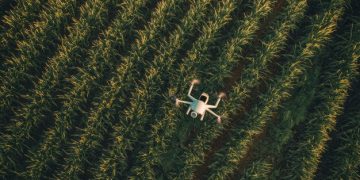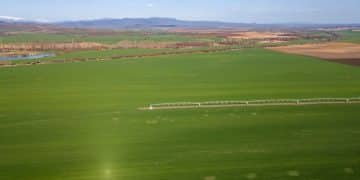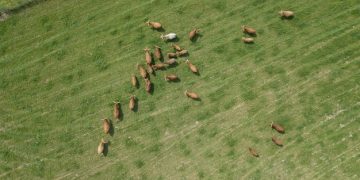Data-Driven Farming: Optimize Fertilizer & Reduce Runoff by 25%
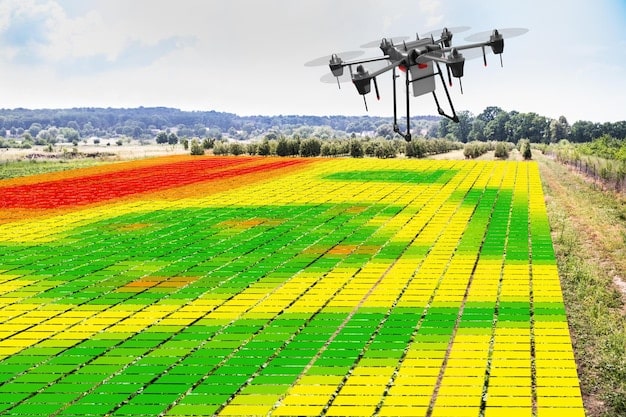
Data-driven farming leverages predictive analytics to optimize fertilizer application, aiming to reduce runoff by 25% through precise nutrient management and environmental stewardship, improving agricultural sustainability and efficiency.
Data-Driven Farming: Using Predictive Analytics to Optimize Fertilizer Application and Reduce Runoff by 25% represents a significant shift in agricultural practices, leveraging technology to enhance efficiency and environmental sustainability. This approach utilizes data to make informed decisions regarding fertilizer application, aiming to minimize waste and reduce harmful runoff. By understanding soil conditions, weather patterns, and crop needs, farmers can tailor their fertilization strategies, leading to improved yields and a smaller environmental footprint.
What is Data-Driven Farming?
Data-driven farming involves using technology and data analysis to make more informed decisions about planting, irrigation, and fertilization. By integrating data from various sources, such as sensors, drones, and weather stations, farmers can gain a comprehensive understanding of their fields and crops.
This approach allows for precise interventions, optimizing resource use and minimizing environmental impact. Let’s explore the key components and benefits of data-driven farming.
Key Components of Data-Driven Farming
Data-driven farming relies on several key technologies and data sources working together to provide actionable insights.
These components include:
- Sensors: Soil sensors, weather stations, and plant sensors provide real-time data on soil moisture, temperature, nutrient levels, and plant health.
- Drones: Drones equipped with multispectral cameras capture high-resolution images of fields, allowing farmers to assess crop health, identify areas of stress, and monitor growth patterns.
- Data Analytics Platforms: These platforms collect, process, and analyze data from various sources, providing farmers with actionable insights and recommendations.
- GPS and GIS Technologies: GPS-guided machinery and GIS mapping tools enable precise application of fertilizers and other inputs, minimizing waste and maximizing efficiency.
Benefits of Data-Driven Farming
The adoption of data-driven farming practices offers numerous advantages for farmers and the environment.
These benefits include:
- Improved Yields: By optimizing fertilizer application and other inputs, farmers can increase crop yields and improve overall productivity.
- Reduced Environmental Impact: Precise nutrient management minimizes fertilizer runoff, reducing pollution of waterways and protecting ecosystems.
- Cost Savings: Efficient resource use reduces waste and lowers input costs, improving profitability for farmers.
- Enhanced Sustainability: Data-driven farming promotes sustainable agricultural practices, ensuring long-term viability and environmental stewardship.
In conclusion, data-driven farming represents a transformative approach to agriculture, leveraging technology and data analysis to optimize resource use, improve yields, and minimize environmental impact.
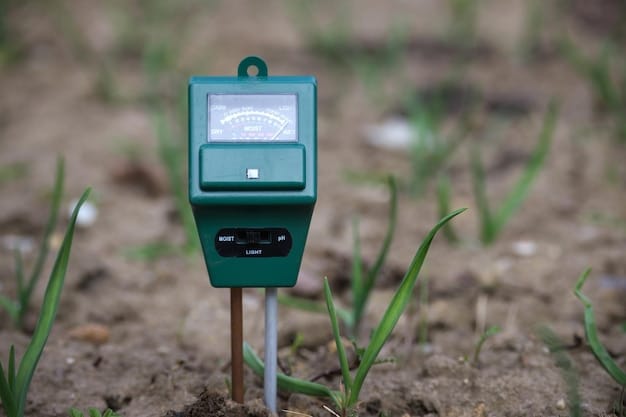
Predictive Analytics in Fertilizer Application
Predictive analytics plays a crucial role in optimizing fertilizer application by forecasting crop nutrient needs based on various data inputs. By analyzing historical data, weather patterns, and soil conditions, farmers can predict nutrient deficiencies and tailor their fertilization strategies accordingly.
This proactive approach not only improves crop health but also minimizes the risk of over-fertilization and nutrient runoff.
Forecasting Crop Nutrient Needs
Predictive analytics models use algorithms to forecast crop nutrient needs based on various factors.
These factors include:
- Historical Yield Data: Analyzing past yield data helps identify patterns and trends in nutrient requirements.
- Soil Analysis: Regular soil testing provides valuable information on nutrient levels and deficiencies.
- Weather Forecasts: Weather patterns, such as rainfall and temperature, can significantly impact nutrient uptake and availability.
- Crop Growth Stage: Different growth stages have varying nutrient needs, which can be predicted using models.
Benefits of Predictive Analytics
The use of predictive analytics in fertilizer application offers several key benefits.
These benefits include:
- Optimized Nutrient Management: Tailoring fertilizer application to crop needs ensures that plants receive the right amount of nutrients at the right time.
- Reduced Fertilizer Waste: By avoiding over-fertilization, farmers can minimize waste and lower input costs.
- Improved Crop Quality: Balanced nutrient supply leads to healthier plants and higher-quality crops.
- Environmental Protection: Reduced fertilizer runoff protects waterways and ecosystems from pollution.
Predictive analytics provides farmers with the insights needed to make informed decisions about fertilizer application, optimizing nutrient management and promoting sustainable agricultural practices.
Reducing Runoff: Environmental Benefits
Reducing fertilizer runoff is a critical aspect of sustainable agriculture, as it helps protect water resources and ecosystems from pollution. Excessive fertilizer application can lead to nutrient runoff, which contaminates waterways and contributes to environmental degradation.
By adopting data-driven farming practices and optimizing fertilizer application, farmers can significantly reduce runoff and minimize their environmental impact.

Impact of Fertilizer Runoff
Fertilizer runoff can have devastating effects on water quality and aquatic ecosystems.
These effects include:
- Eutrophication: Excessive nutrient levels in waterways promote algal blooms, which deplete oxygen and harm aquatic life.
- Contamination of Drinking Water: Fertilizer runoff can contaminate drinking water sources, posing health risks to humans and animals.
- Damage to Aquatic Ecosystems: Nutrient pollution can disrupt the balance of aquatic ecosystems, leading to loss of biodiversity and habitat degradation.
Strategies for Reducing Runoff
Implementing data-driven farming practices can significantly reduce fertilizer runoff and protect water resources.
These strategies include:
- Precision Fertilizer Application: Tailoring fertilizer application to crop needs minimizes excess nutrients that can contribute to runoff.
- Cover Cropping: Planting cover crops helps absorb excess nutrients and prevent soil erosion, reducing runoff.
- Conservation Tillage: Reducing tillage helps maintain soil structure and reduces the risk of erosion and runoff.
- Buffer Zones: Establishing buffer zones along waterways helps filter runoff and trap excess nutrients.
By prioritizing runoff reduction, farmers can protect water resources, enhance biodiversity, and promote long-term sustainability in agriculture.
Technology and Tools for Data-Driven Fertilizer Application
Various technologies and tools are available to support data-driven fertilizer application, enabling farmers to make more informed decisions and optimize nutrient management. These tools range from soil sensors and drones to data analytics platforms and GPS-guided machinery.
By leveraging these technologies, farmers can enhance efficiency, reduce waste, and minimize their environmental impact.
Soil Sensors
Soil sensors provide real-time data on soil moisture, temperature, and nutrient levels, allowing farmers to monitor soil conditions and adjust fertilizer application accordingly.
Different types of soil sensors include:
- Moisture Sensors: Measure soil moisture content to optimize irrigation and reduce water waste.
- Nutrient Sensors: Monitor nutrient levels, such as nitrogen, phosphorus, and potassium, to guide fertilizer application.
- Temperature Sensors: Track soil temperature to optimize planting and fertilization schedules.
Drones and Aerial Imagery
Drones equipped with multispectral cameras capture high-resolution images of fields, providing valuable insights into crop health and nutrient needs.
Aerial imagery can be used to:
- Assess Crop Health: Identify areas of stress or nutrient deficiencies.
- Monitor Growth Patterns: Track crop development and optimize fertilizer application.
- Detect Pests and Diseases: Identify potential threats early and take timely action.
Data Analytics Platforms
Data analytics platforms collect, process, and analyze data from various sources, providing farmers with actionable insights and recommendations.
These platforms can:
- Integrate Data: Combine data from sensors, drones, weather stations, and other sources.
- Analyze Trends: Identify patterns and trends in crop performance and nutrient needs.
- Generate Recommendations: Provide recommendations on fertilizer application, irrigation, and other management practices.
By integrating these technologies and tools into their operations, farmers can embrace data-driven farming and achieve significant improvements in efficiency, sustainability, and profitability.
Case Studies: Successful Implementation
Several case studies demonstrate the successful implementation of data-driven farming practices for optimizing fertilizer application and reducing runoff. These examples highlight the tangible benefits of adopting technology and data analysis in agriculture.
Let’s explore a couple of these case studies to understand the practical application and impact of data-driven farming.
Case Study 1: Precision Fertilizer Application in Corn Farming
A corn farmer in Iowa implemented precision fertilizer application using soil sensors, drones, and data analytics. By monitoring soil nutrient levels and crop health, the farmer was able to tailor fertilizer application to specific needs.
The results included:
- Improved Yields: Corn yields increased by 15% due to optimized nutrient management.
- Reduced Fertilizer Use: Fertilizer use was reduced by 20%, resulting in cost savings and reduced environmental impact.
- Reduced Runoff: Nutrient runoff was reduced by 30%, protecting local waterways from pollution.
Case Study 2: Cover Cropping and Conservation Tillage in Soybean Farming
A soybean farmer in Illinois adopted cover cropping and conservation tillage practices to reduce soil erosion and nutrient runoff. By planting cover crops and minimizing tillage, the farmer was able to improve soil health and reduce environmental impact.
The results included:
- Reduced Soil Erosion: Soil erosion was reduced by 40%, improving soil structure and fertility.
- Reduced Runoff: Nutrient runoff was reduced by 25%, protecting local waterways from pollution.
- Improved Soil Health: Soil organic matter increased by 10%, enhancing soil fertility and water-holding capacity.
These case studies demonstrate the practical benefits of data-driven farming practices, highlighting the potential for improving yields, reducing costs, and minimizing environmental impact.
Challenges and Future Trends
While data-driven farming offers numerous benefits, there are also challenges to consider. These include the initial investment in technology, the need for data management skills, and concerns about data privacy.
However, ongoing advancements in technology and increasing awareness of sustainable agricultural practices are driving the adoption of data-driven farming.
Challenges in Data-Driven Farming
There are several key challenges in the implementation of data-driven farming practices.
These challenges include:
- Initial Investment: Investing in sensors, drones, and data analytics platforms can be costly.
- Data Management Skills: Farmers need to develop skills in data management and analysis to effectively use the technology.
- Data Privacy: Concerns about data privacy and security need to be addressed to ensure trust and adoption.
Future Trends in Data-Driven Farming
Several trends are shaping the future of data-driven farming.
These trends include:
- Artificial Intelligence (AI): AI-powered analytics can provide more accurate and actionable insights.
- Internet of Things (IoT): The integration of IoT devices can provide real-time data from various sources.
- Blockchain Technology: Blockchain can enhance data security and transparency in the agricultural supply chain.
As technology continues to evolve, data-driven farming will become more accessible, affordable, and effective, driving the transformation of agriculture towards sustainability and efficiency.
| Key Point | Brief Description |
|---|---|
| 🌱 Data-Driven Farming | Uses data and technology to optimize farming practices. |
| 📊 Predictive Analytics | Forecasts crop nutrient needs to improve fertilizer application. |
| 💧 Reduced Runoff | Minimizes water pollution from fertilizer overuse. |
| 🚜 Technology Tools | Includes soil sensors, drones, and data platforms for better insights. |
Frequently Asked Questions
▼
The primary goal is to optimize agricultural practices using data and technology, improving efficiency, reducing waste, and promoting sustainability.
▼
It forecasts crop nutrient needs based on data inputs like weather, soil conditions, and historical yields, ensuring precise fertilizer application.
▼
Reducing runoff protects water resources from nutrient pollution, preventing eutrophication and safeguarding aquatic ecosystems and human health.
▼
Common technologies include soil sensors, drones with multispectral cameras, GPS-guided machinery, and data analytics platforms.
▼
Future trends include AI-powered analytics, integration of IoT devices, and blockchain technology for enhancing data security and transparency.
Conclusion
In conclusion, data-driven farming, leveraging predictive analytics to optimize fertilizer application and reduce runoff, represents a transformative approach to modern agriculture. By embracing technology and data, farmers can significantly enhance efficiency, minimize environmental impact, and promote sustainable practices for long-term viability and productivity.


